Nyaungshwe travel - Myanmar, Asia
Nyaungshwe is a charming town located at the northern end of Inle Lake in Shan State, Myanmar, serving as the primary access point to this stunning freshwater lake. Once the capital of the Shan principality of Yawnghwe, Nyaungshwe boasts a vibrant atmosphere with a mix of budget accommodations, local markets, and eateries, making it a hub for travelers exploring the lake's unique floating gardens and stilted villages. Key attractions include the Shwe Yaunghwe Kyaung monastery and the lively Mingalar Market, where visitors can experience local culture and cuisine. Travelers flock to Nyaungshwe for its picturesque landscapes, traditional boat tours on Inle Lake, and the opportunity to witness the unique leg-rowing fishermen in action.
Population: Approximately 200.000 people as of 2024.
Economy: Nyaungshwe's economy is primarily driven by tourism, given its proximity to the stunning Inle Lake, which attracts visitors for its unique landscapes and cultural experiences. The town serves as a hub for various tourist services. You can explore local markets, such as Mingalar Market, where you can purchase fresh produce and handicrafts, contributing to the local economy.
Attractions: Inle Lake, Shwe Yaunghwe Kyaung (Monastery), Mingalar Market, Yadana Man Aung Pagoda, Bawrithat Pagoda, Inle Heritage House, Phaung Daw Oo Pagoda
Myanmar
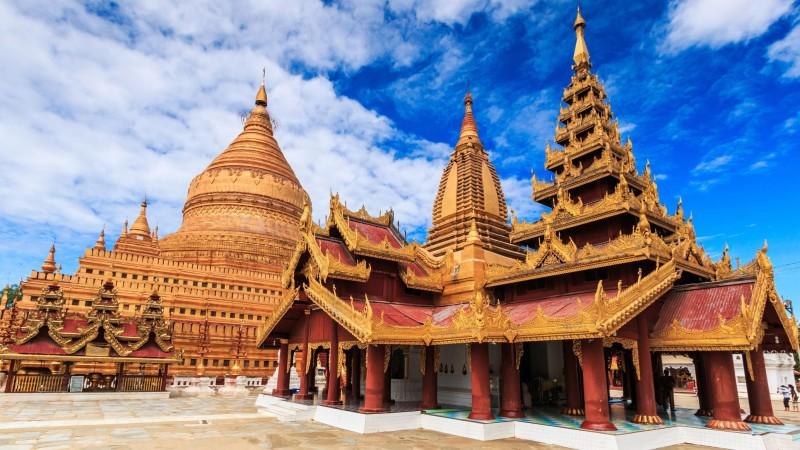
Overview of Nyaungshwe
History & Cultural Influence
Nyaungshwe, also known as Yawnghwe in the Shan language, holds deep historical and cultural significance in Myanmar’s Shan State. Founded in 1359 by two mythical brothers from Tavoy (now Dawei), Nyaungshwe became the capital of one of the most prominent southern Shan States. The city was ruled by a line of Saophas (hereditary rulers) until the mid-20th century, making it a key political and cultural center in the region. In 1887, it became a British protectorate, marking a significant shift in its political history.
Culturally, Nyaungshwe has been shaped by its ethnic diversity, with Intha, Pa-O, Danu, Shan, and Taungyo groups contributing to the region's rich cultural fabric. The area is also a hub for Buddhism, particularly with Inle Lake, famous for its floating gardens and unique leg-rowing fishermen, being a spiritual and cultural landmark. Royal traditions, like the annual Hpaung Daw U Pagoda Festival, where Buddha images are ceremoniously carried across the lake, continue to influence the region’s identity.
Today, Nyaungshwe’s history is preserved in the Nyaungshwe Cultural Museum, once the residence of its last Saopha, Sao Shwe Thaik, who later became the first president of the Union of Burma. The city’s architectural heritage, traditional crafts, and the cultural lifestyle of the lake communities have made it an important tourist destination, blending its royal past with a vibrant modern legacy.
Interaction with The Locals
Locals are generally accommodating and appreciative of the economic opportunities that tourism brings, leading to a positive attitude towards visitors. Many residents are learning English to better communicate with tourists, enhancing the visitor experience.
When interacting with locals, visitors will find that many residents are eager to engage and share their culture. The market scene is particularly lively, with vendors dressed in traditional attire, such as longyis and blouses, and many women applying thanaka, a cosmetic paste made from ground bark, which is a distinctive cultural practice.
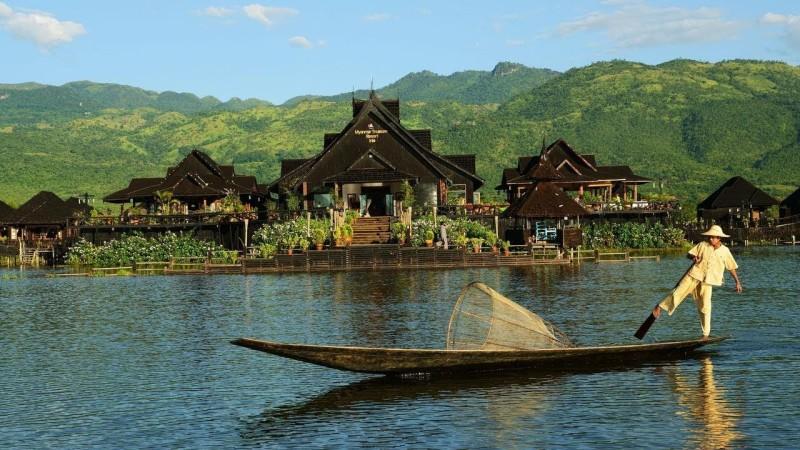
Nyaungshwe Cultural - © gather
Top attractions in Nyaungshwe
Nyaungshwe, the gateway to the serene Inle Lake, offers a captivating blend of natural beauty and cultural heritage. You can explore the bustling Mingala Market, where local Shan and Intha people trade fresh produce and traditional handicrafts, or take a boat ride on Inle Lake to witness the unique floating gardens and the iconic leg-rowing fishermen.
Inle Lake
Location: Inle Lake is situated approximately 20 kilometers south of Nyaungshwe town.
Inle Lake is famous for its breathtaking scenery, where serene waters blend with floating gardens and traditional stilt villages. The sight of local fishermen skillfully maneuvering their boats with one leg is truly captivating. Taking a boat tour across Inle Lake lets you explore vibrant local communities and immerse yourself in the rich cultural tapestry that defines this stunning destination.
Hpaung Daw U Pagoda
Location: located on the western shore of Inle Lake, about 5 kilometers from the town of Nyaungshwe.
Hpaung Daw U Pagoda, located on the western shore of Inle Lake, is one of the region's most revered religious sites. Here, you’ll find five sacred Buddha images, heavily adorned with gold leaf, enshrined within the pagoda. The annual Hpaung Daw U Festival, centered around this pagoda, draws pilgrims and tourists alike, offering a glimpse into the spiritual significance and vibrant celebrations of the area.
Shwe Yan Pyay Monastery
Location: Within Nyaungshwe town, near Inle Lake
Shwe Yan Pyay Monastery, a beautiful wooden structure from the 19th century, enchants with its intricate carvings and peaceful atmosphere. The monastery’s unique oval windows and richly decorated interiors offer you a fascinating glimpse into the spiritual life of the monks, making it a must-visit if you’re interested in Buddhist traditions and history.
Mingalar Market
Location: In the heart of Nyaungshwe town
Mingalar Market is the bustling heart of Nyaungshwe, filled with vibrant colors and the lively atmosphere of local life. Whether you’re searching for fresh produce, handmade textiles, or unique handicrafts, this
market is a treasure trove of authentic experiences and perfect souvenirs to take home.
Red Mountain Estate
Location: Just a short drive about 5 kilometers from the town of Nyaungshwe.
Red Mountain Estate, nestled in the hills overlooking Inle Lake, is more than just a vineyard; it’s a scenic escape. You can enjoy a tour of the vineyard, learn about the winemaking process, and then relax with a glass of wine while taking in stunning panoramic views. The on-site restaurant serves delicious meals that perfectly complement the estate’s wines.
Nyaungshwe Cultural Museum
Location: situated in the heart of Nyaungshwe town, just a short walk from the Shwe Yan Pyay Monastery and the main market area.
The Nyaungshwe Cultural Museum offers you a fascinating insight into the rich cultural heritage of the Shan people. Through its collection of traditional costumes, artifacts, and exhibits, the museum tells the story of the region’s history and customs, deepening your understanding of the local culture.
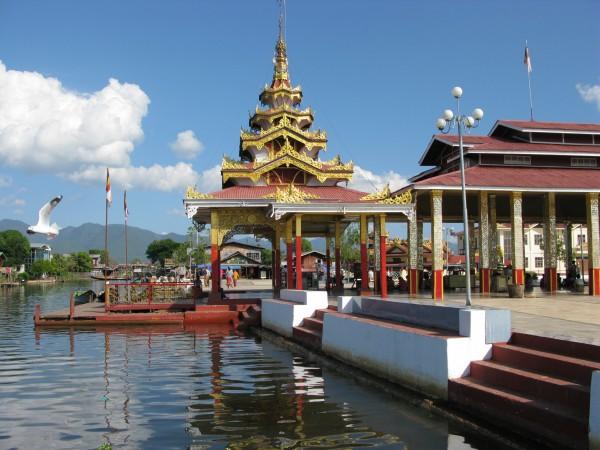
Inle Lake - © gather
Must-Try Dishes in Kyaikto
In Kyaikto, the local cuisine is a flavorful exploration of traditional Burmese dishes with unique regional touches. Must-try dishes include Mohinga, a rich fish broth noodle soup often enjoyed for breakfast, offering a taste of Myanmar's national flavors with fresh local ingredients.
Htamin Gyin
A staple dish for the Intha people of Inle Lake, Htamin Gyin is a flavorful blend of fermented rice kneaded with fish and/or potato, typically served with twice-fried tofu or crispy fritters known as hnapyan gyaw. This hearty dish is a true taste of local tradition, offering a unique culinary experience.
Shan Tomato Salad
Shan Tomato Salad is a fresh and vibrant dish that combines sliced tomatoes with peanuts, shallots, and a sesame seed dressing. It’s a simple yet delicious way to savor the region’s abundant produce, making it a must-try for anyone exploring the flavors of Shan cuisine.
Inle Carp (Nga Hpein)
Inle Carp, a freshwater fish native to Inle Lake, is a dietary staple for the local Intha people. Whether grilled, fried, or prepared in other traditional ways, this fish highlights the vital role of fishing in the local cuisine and provides a delicious, authentic taste of the lake.
Tofu Salad
A common dish in Shan and Intha cuisine, Tofu Salad features either fried or fermented tofu that adds texture and flavor to the mix. This salad is a delightful way to experience the versatile use of tofu in the region’s culinary traditions.
Shan Noodles
Shan Noodles are a signature dish of the Shan State, featuring flat, hand-pulled noodles served in a savory meat or fish-based broth. Widely available at local restaurants in Nyaungshwe, this dish is a comforting and satisfying meal that showcases the rich flavors of Shan cuisine.
Braised Chicken with Mint and Green Pepper
This traditional Shan dish brings together tender braised chicken with fresh mint and green peppercorns, creating a unique and flavorful combination. It’s a distinctive taste of the region that reflects the bold and aromatic ingredients typical of Shan cooking.
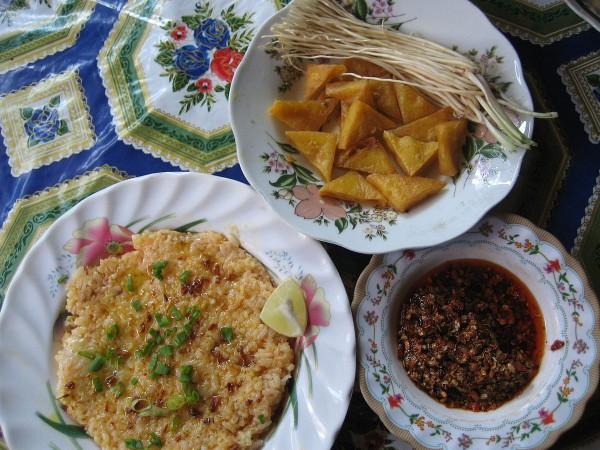
Htamin Gyin - © gather
Festivals & Local Celebrations
Hpaung Daw U Festival
Time of Year: September to October
This is one of the most significant festivals in the region, celebrated for about 18 days. The festival features a grand procession of the Hpaung Daw U Pagoda’s revered Buddha images, which are carried on a royal barge across Inle Lake. Visitors can expect lively boat races, traditional music, and dance performances, along with the opportunity to witness the unique leg-rowing fishermen in action.
Thadingyut Festival
Time of Year: October (during the full moon of the seventh lunar month)
Thadingyut, also known as the Festival of Lights, marks the end of the Buddhist Lent. In Nyaungshwe, the festival is celebrated with illuminated streets, colorful decorations, and offerings made to monks. Visitors can enjoy the vibrant atmosphere, participate in local ceremonies, and witness the community coming together to celebrate with food and festivities.
Water Festival (Thingyan)
Time of Year: Mid-April
The Thingyan Water Festival, which marks the Burmese New Year, is celebrated with great enthusiasm in Nyaungshwe. The festival involves water throwing, symbolizing the washing away of sins and bad luck. Visitors can join in the fun, enjoy traditional music and dance, and experience the festive spirit as locals engage in water fights and celebrations throughout the town.
Inle Lake Festival
Time of Year: Varies (usually in November)
This festival celebrates the unique culture of the Intha people and takes place on Inle Lake. It features traditional boat races, cultural performances, and local food stalls. Visitors can immerse themselves in the local culture, enjoy the beautiful scenery of the lake, and witness the vibrant community spirit.
Nyaungshwe Cultural Festival
Time of Year: Varies (often in December)
This festival showcases the diverse cultural heritage of the Shan State, with performances of traditional music, dance, and art. Visitors can expect to see local artisans displaying their crafts, taste regional cuisine, and participate in various cultural activities that highlight the traditions of the Shan people.
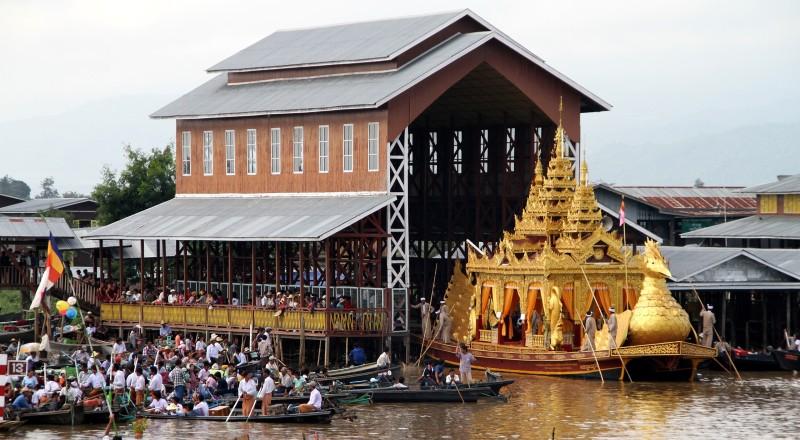
Hpaung Daw U Festival - © gather
Weather in Kyaikto: Best Time to Visit
Nyaungshwe has a mild, generally warm and temperate climate. The weather varies throughout the year, with distinct wet and dry seasons. Here are the key points about Nyaungshwe's weather and climate:
Temperature
Average temperatures range from 17.1°C (62.8°F) in January to 24.4°C (75.9°F) in April, the hottest month.
The coolest month is January with an average low of 11.9°C (53.3°F) and high of 23.3°C (73.9°F).
Summers are short, hot, and partly cloudy, while winters are short, comfortable, and mostly clear.
Rainfall
Nyaungshwe has a dry climate year-round, with the lowest rainfall in February at just 3mm (0.1 inches).
The wettest month is August, with an average of 202mm (8 inches) of precipitation.
The difference in rainfall between the driest and wettest months is 199mm (8 inches).
Best Time to Visit
The best times to visit Nyaungshwe for warm-weather activities are from early February to early April, with a peak in the first week of March.
The beach/pool score favors clear, rainless days from late March to early May, with the second week of April being the best.
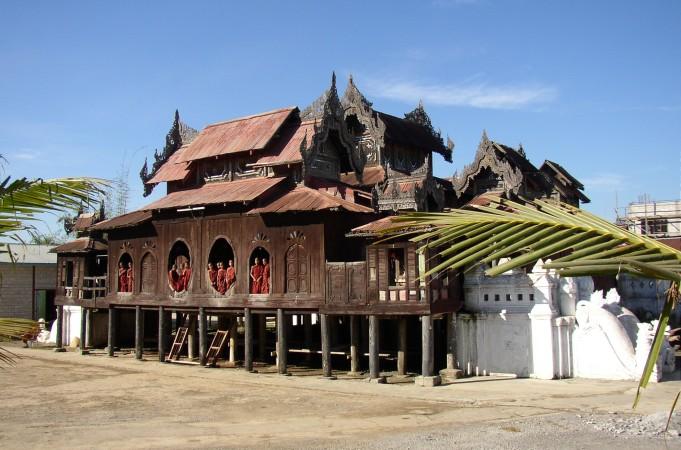
Shwe Yan Pyay Monastery - © Ralf-André Lettau
Culture Etiquette in Kyaikto
Dress Modestly
Visitors should dress modestly, especially when visiting religious sites such as pagodas and monasteries. This typically means covering shoulders and knees. Wearing traditional garments, like the longyi (a sarong-like garment worn by both men and women), can also help you blend in and show respect for local customs.
Remove Shoes Indoors
It is customary to remove your shoes before entering someone’s home or certain sacred places. Be prepared to follow this practice, as it reflects respect for the space and its inhabitants.
Respect Religious Practices
Nyaungshwe is home to numerous Buddhist temples and monasteries. When visiting these sites, maintain a respectful demeanor—avoid loud conversations, and do not interrupt ceremonies. Photography may be restricted in certain areas, so always ask for permission when in doubt.
Use Your Right Hand
In Burmese culture, the right hand is considered more polite for giving and receiving items, as well as for gestures. The left hand may be viewed as impolite, so try to use your right hand when interacting with locals.
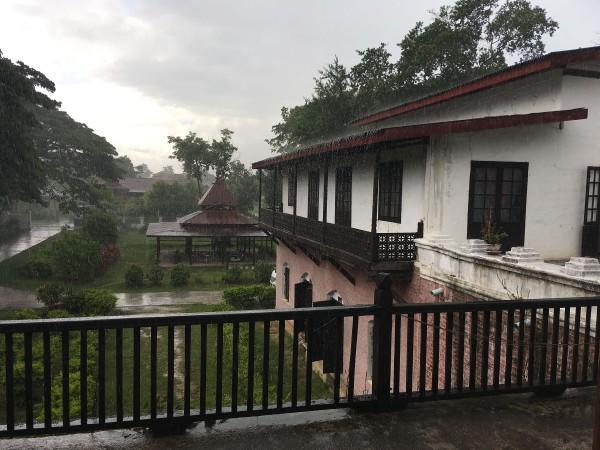
Nyaungshwe Cultural Museum - © gather
Essential Travel Information
Getting to Nyaungshwe
By Air
Heho Airport: The nearest airport is Heho, located about 32 kilometers northwest of Nyaungshwe. Flights from Yangon to Heho take about 1 hour. After landing, visitors can take a taxi to Nyaungshwe, which takes approximately 45 minutes and costs around K25,000 (about $18) .
By Bus
Long-Distance Buses: Nyaungshwe is accessible by bus from major cities like Yangon, Mandalay, and Kalaw. Buses typically arrive at the town center, and some hotels are within walking distance from the drop-off point. Taxi fares from the bus station to hotels usually range from K1,500 to K7,000, depending on the distance .
By Train
Shwe Nyaung Station: The nearest train station is in Shwe Nyaung, about 13 kilometers from Nyaungshwe. Visitors can take a motorcycle taxi from the station to Nyaungshwe for around K6,000. Trains from Yangon or Thazi to Shwe Nyaung are available, but this option can be slower compared to buses .
Getting Around Nyaungshwe
Public Transit
Bicycles: Renting bicycles is a popular way to explore Nyaungshwe, with several shops offering rentals for around K1,500 per day. This is an excellent way to enjoy the scenic surroundings at your own pace .
Taxis and Motorcycle Taxis
Motorcycle Taxis: Available at stands near the market, these taxis are a quick way to get around town or to nearby locations like Shwenyaung. Fares typically start around K6,000 for short distances .
Boat Rides
Long Boats: Nyaungshwe serves as the main access point to Inle Lake, and numerous long boats are available for hire to explore the lake and its attractions. Prices for boat trips usually start at K25,000 for a full-day tour, which can vary based on the distance and destinations included.
ATM and Banking Services
Nyaungshwe has several ATM locations available for cash withdrawals:
- KBZ Bank ATM - Located at No. 5, Yone Gyi Street, Nandawun Quarter. Open 24 hours.
- CB Bank ATMs - There are multiple CB Bank ATM locations in Nyaungshwe, including at Mount Inle Resort Hotel, Nanthu Village near Inle Phaung Taw Oo Pagoda, Inlay Lake, and in the town center. All are open 24 hours.
- KBZ Auto Banking - Located in nearby Shwe Nyaung, about 15km from Nyaungshwe.
The main bank with ATM services in Nyaungshwe is CB Bank, with KBZ Bank also having an ATM in the town center. Visitors can easily access cash from these ATMs located at hotels, pagodas and in the town itself.
Accommodation
Nyaungshwe offers a range of accommodation options for visitors:
- Hotels - There are numerous hotels in Nyaungshwe catering to different budgets, from budget guesthouses to luxury resorts. Some popular options include Amata Garden Resort, Nyaung Shwe Hotel, and Inle Inn.
- Inns and Guesthouses - For more affordable options, Nyaungshwe has many inns and guesthouses, such as Shwe Inn Thar Guesthouse, Paramount Inle Hotel, and Inle Apex Hotel.
- Resorts - For a more luxurious stay, resorts like Aureum Palace Hotel & Resort Inle, Sanctum Inle Resort, and Inle Lake View Resort & Spa offer stunning lakeside locations and amenities.
- Homestays - Experiencing local hospitality is possible through homestays in Nyaungshwe. Operators like Inle Heritage House and Inle Lake Cottage offer this unique accommodation option.
Articles for you

Explore Yala National Park - Sri Lanka Travel, Asia
Tucked away in Sri Lanka’s southeastern corner, Yala National Park is where wild nature meets deep tradition. Known worldwide for its leopard population, the park is also home to elephants, sloth bears, crocodiles, and hundreds of bird species. Beyond wildlife, Yala opens doors to a cultural landscape dotted with ancient temples, Buddhist ruins, and coastal villages. For travelers seeking more than just a safari, Yala offers a chance to explore eco-tourism, local communities, and sacred heritage sites.
Population: The Yala National Park area doesn’t have a human population.
Economy: The economy around Yala National Park thrives on a blend of eco-tourism, agriculture, and local services. Safari tours, eco-lodges, and cultural experiences drive steady income for nearby towns like Tissamaharama and Kataragama, supporting thousands of families.
Landmarks: Famous for Block I of Yala and wildlife encounters, including elephants, sloth bears, crocodiles, and exotic bird species.

Explore Galle - Sri Lanka Travel, Asia
Nestled on Sri Lanka’s southern coastline, Galle is a vibrant city where history meets the sea. Its cobbled streets, colonial architecture, and serene beaches make it a must-visit destination for travelers seeking a blend of culture, adventure, and relaxation. A UNESCO World Heritage site, Galle captivates visitors with its Dutch Fort, bustling markets, and friendly locals. Whether you’re exploring the ramparts at sunset or savoring fresh seafood by the shore, Galle promises an unforgettable journey into Sri Lanka’s heritage.
Population: Approximately 113,000 in 2023.
Economy: Galle’s economy thrives on tourism, trade, and fisheries. The city’s historic fort, colonial architecture, and coastal charm draw thousands of international visitors each year, making tourism its main economic driver. Fishing remains vital for local livelihoods, supplying fresh seafood across the region.
Landmarks: Famous for the Galle Fort, Dutch Reformed Church & Maritime Museum, and Unawatuna Beach.

Explore Bentota - Sri Lanka Travel, Asia
Nestled along Sri Lanka’s southwestern coast, Bentota is a tropical paradise that blends golden beaches, vibrant culture, and thrilling adventures. Famous for its calm waters, luxury resorts, and scenic river estuary, Bentota has become a top destination for travelers seeking both relaxation and authentic experiences. From serene beach walks at sunrise to adrenaline-pumping water sports, this coastal town offers a perfect balance of leisure and exploration. With its proximity to Colombo and Galle, Bentota is easy to reach, making it an ideal stop for both short escapes and extended holidays.
Population: Approximately 37,000 in 2023.
Economy: Bentota’s economy thrives mainly on tourism, which drives local businesses such as hotels, restaurants, and wellness retreats. The town also benefits from fishing, coconut cultivation, and handicrafts like wood carving and batik textiles. Many residents rely on the growing demand for water sports and Ayurvedic treatments, making tourism the backbone of both income and employment in the area.
Landmarks: Famous for Bentota Beach, Bentota River Safari, and Kande Vihara Temple.

Explore Mirissa - Sri Lanka Travel, Asia
Mirissa is a charming coastal town on Sri Lanka’s southern shoreline. Known for its golden beaches, turquoise waters, and vibrant marine life, it has become a must-visit stop for travelers exploring the island. Many come for whale watching, surfing, and sunset views at Coconut Tree Hill, but Mirissa offers much more than postcard beauty. The fishing boats you see anchored by the bay carry generations of stories. Local traditions, delicious cuisine, and a laid-back rhythm of life shape every visitor’s experience.
Population: Approximately 4,700 in 2023.
Economy: Mirissa’s economy is largely shaped by its coastal location. Fishing has long been the backbone of local livelihoods, with generations relying on the Indian Ocean for income. In recent decades, tourism has become the main driver of growth, thanks to whale watching, surfing, and beachside hospitality.
Landmarks: Famous for Mirissa Beach, Coconut Tree Hill, and Parrot Rock Bridge.

Explore Nuwara Eliya - Sri Lanka Travel, Asia
Tucked away in the Central Highlands of Sri Lanka, Nuwara Eliya is often called “Little England”. With its rolling tea plantations, cool misty mornings, and colonial charm, this mountain town feels like a step into another world. Travelers come here to breathe fresh air, walk through flower gardens, sip the finest Ceylon Tea, and enjoy a pace of life far from the island’s busy cities. Whether you’re drawn by scenic landscapes, heritage architecture, or the warmth of its people, Nuwara Eliya is a destination that blends nature, culture, and history in perfect harmony.
Population: Approximately 781,000 in 2023.
Economy: Nuwara Eliya’s economy thrives mainly on tea production, as it sits in the heart of Sri Lanka’s central highlands, famous worldwide for Ceylon Tea. The city also benefits from a growing tourism industry, attracting visitors with its colonial charm, cool climate, and scenic landscapes.
Landmarks: Famous for Gregory Lake, Hakgala Botanical Garden, and Victoria Park.

Explore Sukau - Malaysia Travel, Asia
Nestled on the banks of the Kinabatangan River in Sabah, Malaysian Borneo, Sukau is a destination where wildlife, culture, and conservation come together. Known as one of Asia’s top spots for river safaris and eco-tourism, this quiet village offers a front-row seat to encounters with Bornean orangutans, pygmy elephants, proboscis monkeys, and exotic birdlife.
Population: Approximately 1,400 in 2019.
Economy: Sukau’s economy is shaped by its riverine location and natural resources. Traditionally, the Orang Sungai community relied on fishing, small-scale farming, and forest gathering for their livelihood. Today, the village has shifted toward eco-tourism, with river cruises, jungle trekking, and homestays providing income.
Landmarks: Famous for the Kinabatangan River cruises, Gomantong Caves, and Ox-bow lakes and wetlands.
